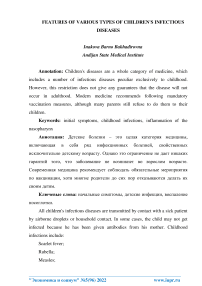Features of various types of children's infectious diseases
Автор: Inakova B.B.
Журнал: Экономика и социум @ekonomika-socium
Рубрика: Основной раздел
Статья в выпуске: 5-1 (96), 2022 года.
Бесплатный доступ
Children's diseases are a whole category of medicine, which includes a number of infectious diseases peculiar exclusively to childhood. However, this restriction does not give any guarantees that the disease will not occur in adulthood. Modern medicine recommends following mandatory vaccination measures, although many parents still refuse to do them to their children.
Initial symptoms, childhood infections, inflammation of the nasopharynx
Короткий адрес: https://sciup.org/140291989
IDR: 140291989
Текст научной статьи Features of various types of children's infectious diseases
All children's infectious diseases are transmitted by contact with a sick patient by airborne droplets or household contact. In some cases, the child may not get infected because he has been given antibodies from his mother. Childhood infections include:
Scarlet fever;
Rubella;
Measles;
Chickenpox;
Polio;
Whooping cough;
Viral mumps (mumps).
Diseases such as acute respiratory infections, intestinal infections, meningitis, mononucleosis are also often recorded in childhood. But they are often found in adults, so it is inappropriate to classify them as childhood infections.
Measles refers to infections with a high degree of contagiousness. The infectious agent spreads with the flow of air, while it does not die quickly in the external environment. The incubation period averages 20 days. The initial symptoms are very similar to a common cold, and around the 4th day a rash appears that spreads throughout the body. Even on the mucous membranes in the mouth, small-point formations are observed. The temperature with measles lasts until the rash disappears. But it is important to understand that this is a very serious disease for the child's immune system, so bronchitis, otitis media and even pneumonia are often observed after measles.
The incubation period lasts from 7 to 20 days. The first symptoms include the appearance of headaches, which is not surprising, since the nervous system suffers from this disease, and a high temperature of up to 39 degrees is maintained. The infection also affects the pancreas, and boys have testicles, therefore, male infertility is often diagnosed after the disease in adulthood.
The disease is very serious, it can be complicated by meningitis, so it is important not to refuse vaccination and consult a doctor at the first signs of the disease.
The causative agent of the disease is diphtheria bacillus, and the child is infected by its negative effect on the tonsils. Symptoms appear on average 10 days after infection, the main one is considered to be a gray plaque on the tonsils – it distinguishes the disease from angina. Diphtheria is dangerous for the life of a child, so you should not refuse to vaccinate DPT, because it was she who turned this disease into a rare infection.
This is a viral infection, the incubation period of which can reach 30 days, although in fact it is much shorter. The symptoms of infection can be called classic for a viral lesion, but there is still one difference - it is pain in the extremities. To prevent infection, you need to get vaccinated.
The infection has many similarities with measles – the same rash and fever. But there is one difference – with rubella, the lymph nodes become inflamed, but it is much easier to tolerate, and the rash goes away earlier.
Infectious diseases should be treated only by a doctor. Given that many childhood infections have common features, and the onset of the disease is almost always the same, you can't do without a specialist. Self-medication of children can lead to undesirable or negative consequences, as well as the choice of a poorquality doctor. That is why you should use the services of only qualified specialists with work experience.
A group of children's infections differs in the way of transmission only from a sick person to a healthy person, therefore, the probability of rapid morbidity of children in schools and kindergartens, in other places with active attendance of children is very high. An important measure to prevent the spread of infections among children is a set of vaccinations carried out in accordance with a certain schedule for different age groups. Vaccination measures significantly reduce the epidemic burden, but all parents should know the ways of spreading, symptoms and types of childhood infectious diseases.
The symptoms of childhood infections have similar signs, therefore, for qualified treatment, differentiated diagnostics carried out in laboratory conditions by medical institutions is necessary. The following manifestations are considered characteristic symptoms of infectious diseases in children:
feverish condition with febrile temperature;
rashes on the trunk, limbs and face of the child (the nature of the rash varies from small with a reddish tinge to spotted with a brownish tinge, as well as with the formation of papules and wet wounds);
inflammation and swelling of the salivary glands located near the ears;
coughing attacks with pronounced spasms or barking sound;
general weakness, lack of appetite;
wheezing and inflammation of the nasopharynx with pain when swallowing and hoarseness of voice;
inflammation of the oral mucosa and the development of conjunctivitis;
intestinal disorders against the background of intoxication of the body.
The basis of success in the treatment of childhood infections is an accurate diagnosis with the determination of the pathogen, which is possible only in a well-equipped laboratory.
Список литературы Features of various types of children's infectious diseases
- Karetkina G.N. Influenza, ARVI: problems of prevention and treatment. Infectious diseases: News. Opinions. Training. 2015, 4 (13): 25-34.
- EDN: VFKHQF
- Karetkina G.N. Influenza, ARVI: problems of prevention and treatment. Infectious diseases: News. Opinions. Training. 2015, 4 (13): 25-34 (in Russian).
- EDN: VFKHQF
- Kovalenko L.P., Tallerova A.V., Kuznetsova O.S. and others. Experimental study of allergenic properties and immunotoxicity of the drug Ocillococcinum. Toxicological Bulletin. 2015, 1 (130): 37-41.
- EDN: YWWCXR
- Selkova E.P., Semenenko T.A., Gorbachev IA. The use of Ocillococcinum for the prevention and treatment of influenza and SARS. Infectious diseases. 2005, 3 (4): 74-8.


